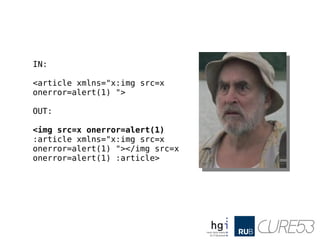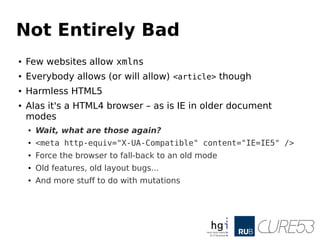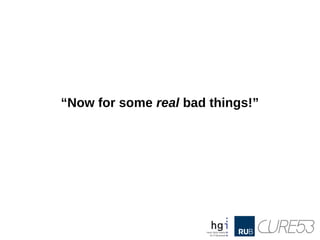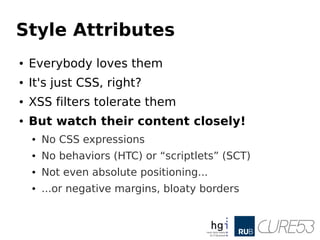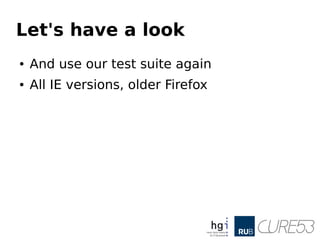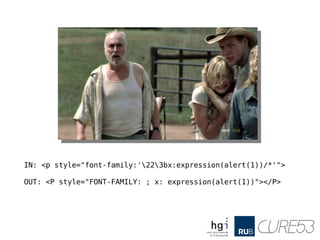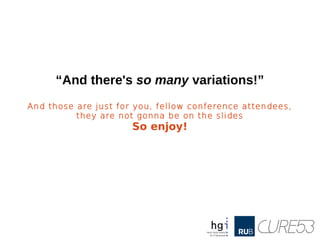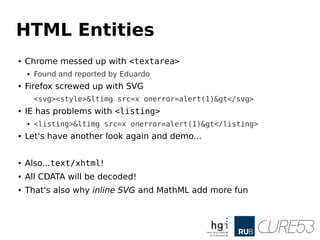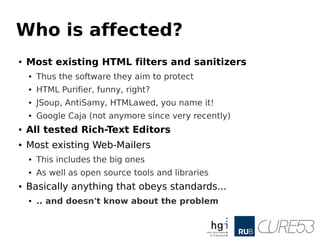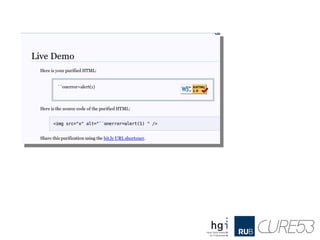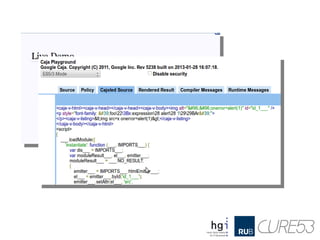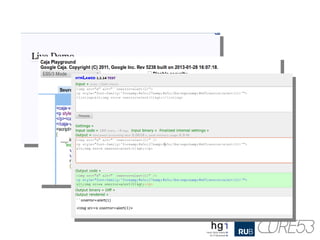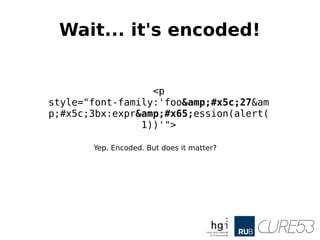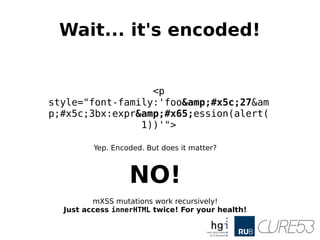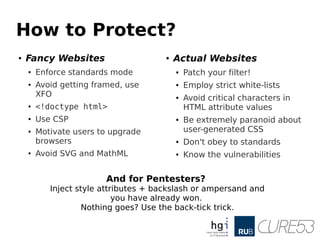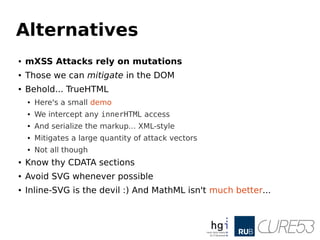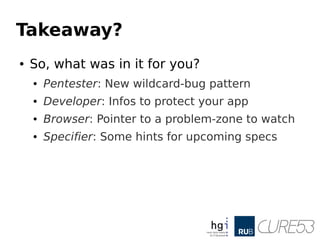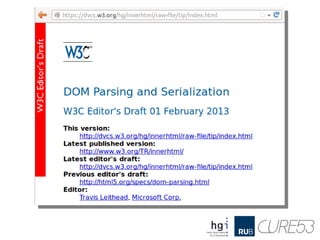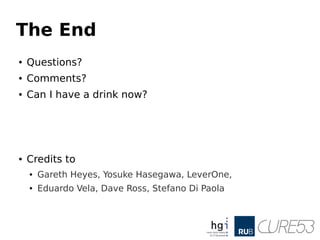The innerHTML Apocalypse
- 1. The innerHTML Apocalypse How mXSS attacks change everything we believed to know so far A presentation by Mario Heiderich mario@cure53.de || @0x6D6172696F
- 2. Our Fellow Messenger ● Dr.-Ing. Mario Heiderich ● Researcher and Post-Doc, Ruhr-Uni Bochum – PhD Thesis on Client Side Security and Defense ● Founder of Cure53 – Penetration Testing Firm – Consulting, Workshops, Trainings – Simply the Best Company of the World ● Published author and international speaker – Specialized in HTML5 and SVG Security – JavaScript, XSS and Client Side Attacks ● HTML5 Security Cheatsheet – @0x6D6172696F – mario@cure53.de
- 3. Research Focus ● Everything inside <> ● HTML 2.0 – 5.1 ● JavaScript / JScript, VBS ● Plug-ins and Controls ● Editable Rich-Text ● SVG, MathML, XLS, XDR ● CSS, Scriptless Attacks ● ES5 / ES6 ● DOM Clobbering ● No binary stuff. My brain cannot :) ● Offense ● Injection Scenarios ● Active File formats ● Parser Analysis ● Archeology & Legacy Porn ● Defense ● XSS Filter / WAF / IDS ● CSP, DOM-based XSS Filter ● DOM Policies ● DOM + Trust & Control
- 4. Why? ● HTML on its way to ultimate power ● Websites and Applications ● Instant Messengers and Email Clients ● Local documentation and presentations ● Router Interfaces and coffee-machine UIs ● Medical Devices – according to this source ● Operating systems, Win8, Tizen ● HTML + DOM + JavaScript ● “I mean look at friggin' Gmail!” ● I measured the amount of JavaScript on 27th of Jan. 2013 ● It was exactly 3582,8 Kilobytes of text/javascript
- 5. Defense ● Several layers of defense over the years ● Network-based defense, IDS/IPS, WAF ● Server-side defense, mod_security, others ● Client-side defense, XSS Filter, CSP, NoScript ● “We bypassed, they fixed.” ● A lot of documentation, sometimes good ones too! ● Hundreds of papers, talks, blog posts ● Those three horsemen are covered quite well!
- 6. Horsemen? ● Reflected XSS ● The White Horse – “Purity”. Easy to understand, detect and prevent. ● Stored XSS ● The Red Horse – “War”. Harder to detect and prevent – where rich-text of benign nature is needed. ● DOMXSS ● The Black Horse – “Disease”. Harder to comprehend. Often complex, hard to detect and prevent.
- 7. “But what's a proper apocalypse without...”
- 9. “Enough with the kitsch, let's get technical”
- 10. Assumptions ● Reflected XSS comes via URL / Parameters ● We can filter input properly ● Persistent XSS comes via POST / FILE ● We can filter output properly ● Tell good HTML apart from bad ● DOMXSS comes from DOM properties ● No unfiltered usage of DOMXSS sources ● We can be more careful with DOMXSS sinks ● We can create safer JavaScript business logic ● Following those rules + handling Uploads properly + setting some headers mitigates XSS. Right?
- 11. That telling apart... ● Advanced filter libraries ● OWASP Antisamy / XSS Filter Project ● HTML Purifier ● SafeHTML ● jSoup ● Many others out there ● Used in Webmailers, CMS, Social Networks ● Intranet, Extranet, WWW, Messenger-Tools, Mail-Clients ● They are the major gateway between ● Fancy User-generated Rich-Text ● And a persistent XSS ● Those things work VERY well! ● Without them working well, shit would break
- 12. “But what if we can fool those tools? Just ship around them. Every single one of them?”
- 13. Convenience
- 14. Decades Ago... ● MS added a convenient DOM property ● It was available in Internet Explorer 4 ● Allowed to manipulate the DOM... ● … without even manipulating it... ● … but have the browser do the work! ● element.innerHTML ● Direct access to the elements HTML content ● Read and write of course ● Browser does all the nasty DOM stuff internally
- 15. Look at this // The DOM way var myId = "spanID"; var myDiv = document.getElementById("myDivId"); var mySpan = document.createElement('span'); var spanContent = document.createTextNode('Bla'); mySpan.id = mySpanId; mySpan.appendChild(spanContent); myDiv.appendChild(mySpan); // The innerHTML way var myId = "spanID"; var myDiv = document.getElementById("myDivId"); myDiv.innerHTML = '<span id="'+myId+'">Bla</span>';
- 16. Compared ● Pro ● It's easy ● It's fast ● It's now a standard ● It just works ● It's got a big brother.. outerHTML ● Contra ● Bit bitchy with tables ● Slow on older browsers ● No XML ● Not as “true” as real DOM manipulation
- 17. Who uses it?
- 18. Rich Text Editors ● The basically exist because of innerHTML ● And of course contentEditable ● And they are everywhere ● CMS ● Webmailers ● Email Clients ● Publishing Tools
- 19. “Now, what's the problem with all this?”
- 20. Internals ● We might be naïve and assume: ● ƒ(ƒ(x)) ≡ ƒ(x) ● Idempotency ● An elements innerHTML matches it's actual content ● But it doesn't ● It's non-idempotent and changes! ● And that's usually even very good! ● Performance ● Bad markup that messes up structure ● Illegal markup in a sane DOM tree
- 21. Examples ● We have a little test-suite for you ● Let's see some examples ● And why non-idempotency is actually good IN: <div>123 OUT: <div>123</div> IN: <Div/class=abc>123 OUT: <div class="abc">123</div> IN: <span><dIV>123</span> OUT: <span><div>123</div></span>
- 22. Funny Stuff ● So browsers change the markup ● Sanitize, beautify, optimize ● There's nothing we can do about it ● And it often helps ● Some funny artifacts exist... ● Comments for instance ● Or try CDATA sections for a change... IN: <!-> OUT: <!-----> IN: <!--> OUT: <!----> IN: <![CDATA]> OUT: <!--[CDATA]-->
- 23. “And what does it have to do with security again?”
- 24. It was back in 2006... ● .. when a fellow desk-worker noticed a strange thing. Magical, even!
- 25. The Broken Preview ● Sometimes print preview was bricked ● Attribute content bled into the document ● No obvious reason... ● Then Yosuke Hasegawa analyzed the problem ● One year later in 2007 ● And discovered the first pointer to mXSS
- 26. Now let's have a look ● DEMO ● Requires IE8 or older
- 27. IN: <img src="foo" alt="``onerror=alert(1)" /> OUT: <IMG alt=``onerror=alert(1) src="x">
- 28. Pretty bad ● But not new ● Still, works like a charm! ● Update: A patch is on the way! ● Update II: Patch is out! ● But not new ● Did you like it though? ● Because we have “new” :)
- 29. Unknown Elements ● Again, we open our test suite ● Requires IE9 or older ● Two variations – one of which is new ● The other discovered by LeverOne
- 30. IN: <article xmlns="><img src=x onerror=alert(1)"></article> OUT: <?XML:NAMESPACE PREFIX = [default] ><img src=x onerror=alert(1) NS = "><img src=x onerror=alert(1)" /><article xmlns="><img src=x onerror=alert(1)"></article>
- 31. IN: <article xmlns="x:img src=x onerror=alert(1) "> OUT: <img src=x onerror=alert(1) :article xmlns="x:img src=x onerror=alert(1) "></img src=x onerror=alert(1) :article>
- 32. Not Entirely Bad ● Few websites allow xmlns ● Everybody allows (or will allow) <article> though ● Harmless HTML5 ● Alas it's a HTML4 browser – as is IE in older document modes ● Wait, what are those again? ● <meta http-equiv="X-UA-Compatible" content="IE=IE5" /> ● Force the browser to fall-back to an old mode ● Old features, old layout bugs... ● And more stuff to do with mutations
- 33. “Now for some real bad things!”
- 34. Style Attributes ● Everybody loves them ● It's just CSS, right? ● XSS filters tolerate them ● But watch their content closely! ● No CSS expressions ● No behaviors (HTC) or “scriptlets” (SCT) ● Not even absolute positioning... ● ...or negative margins, bloaty borders
- 35. Let's have a look ● And use our test suite again ● All IE versions, older Firefox
- 36. IN: <p style="font-family:'223bx:expression(alert(1))/*'"> OUT: <P style="FONT-FAMILY: ; x: expression(alert(1))"></P>
- 37. “And there's so many variations!” And those are just for you, fellow conference attendees, they are not gonna be on the slides So enjoy!
- 38. HTML Entities ● Chrome messed up with <textarea> ● Found and reported by Eduardo ● Firefox screwed up with SVG <svg><style><img src=x onerror=alert(1)></svg> ● IE has problems with <listing> ● <listing><img src=x onerror=alert(1)></listing> ● Let's have another look again and demo... ● Also...text/xhtml! ● All CDATA will be decoded! ● That's also why inline SVG and MathML add more fun
- 39. Who is affected? ● Most existing HTML filters and sanitizers ● Thus the software they aim to protect ● HTML Purifier, funny, right? ● JSoup, AntiSamy, HTMLawed, you name it! ● Google Caja (not anymore since very recently) ● All tested Rich-Text Editors ● Most existing Web-Mailers ● This includes the big ones ● As well as open source tools and libraries ● Basically anything that obeys standards... ● .. and doesn't know about the problem
- 43. Wait... it's encoded! <p style="font-family:'foo&#x5c;27&am p;#x5c;3bx:expr&#x65;ession(alert( 1))'"> Yep. Encoded. But does it matter?
- 44. Wait... it's encoded! <p style="font-family:'foo&#x5c;27&am p;#x5c;3bx:expr&#x65;ession(alert( 1))'"> Yep. Encoded. But does it matter? NO! mXSS mutations work recursively! Just access innerHTML twice! For your health!
- 46. How to Protect? ● Fancy Websites ● Enforce standards mode ● Avoid getting framed, use XFO ● <!doctype html> ● Use CSP ● Motivate users to upgrade browsers ● Avoid SVG and MathML ● Actual Websites ● Patch your filter! ● Employ strict white-lists ● Avoid critical characters in HTML attribute values ● Be extremely paranoid about user-generated CSS ● Don't obey to standards ● Know the vulnerabilities And for Pentesters? Inject style attributes + backslash or ampersand and you have already won. Nothing goes? Use the back-tick trick.
- 47. Alternatives ● mXSS Attacks rely on mutations ● Those we can mitigate in the DOM ● Behold... TrueHTML ● Here's a small demo ● We intercept any innerHTML access ● And serialize the markup... XML-style ● Mitigates a large quantity of attack vectors ● Not all though ● Know thy CDATA sections ● Avoid SVG whenever possible ● Inline-SVG is the devil :) And MathML isn't much better...
- 48. Takeaway? ● So, what was in it for you? ● Pentester: New wildcard-bug pattern ● Developer: Infos to protect your app ● Browser: Pointer to a problem-zone to watch ● Specifier: Some hints for upcoming specs
- 50. Wrapping it up ● Today we saw ● Some HTML, DOM and browser history ● Some old yet unknown attacks revisited ● Some very fresh attacks ● A “pentest joker” ● Some guidelines on how to defend ● The W3C's silver bullet. For 2015 maybe.
- 51. The End ● Questions? ● Comments? ● Can I have a drink now? ● Credits to ● Gareth Heyes, Yosuke Hasegawa, LeverOne, ● Eduardo Vela, Dave Ross, Stefano Di Paola

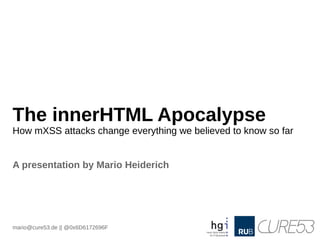

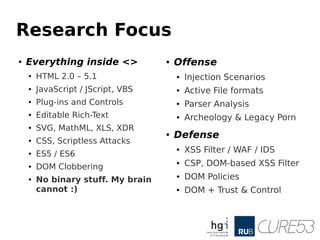
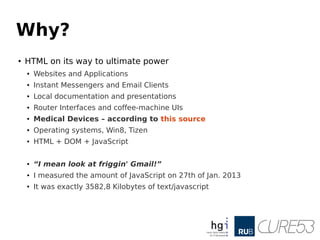
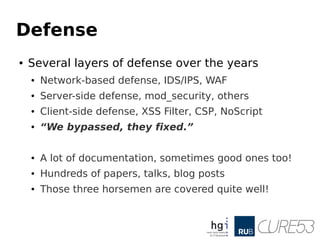
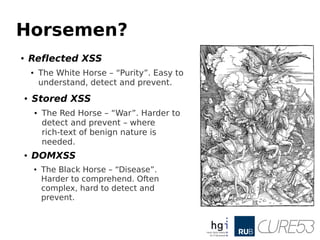
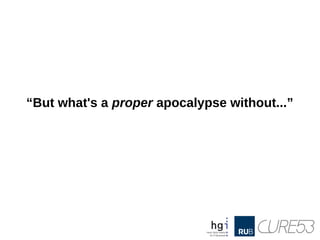


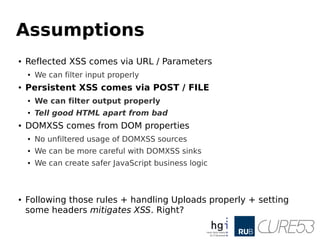
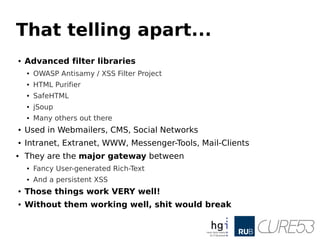
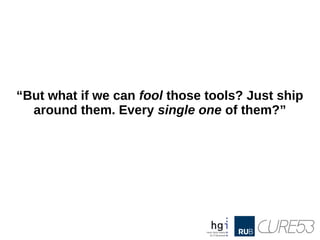


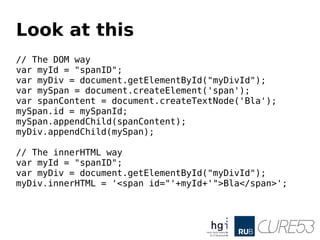
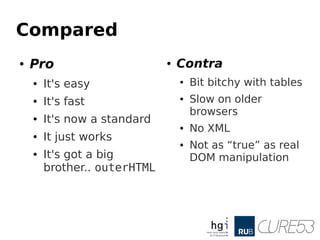
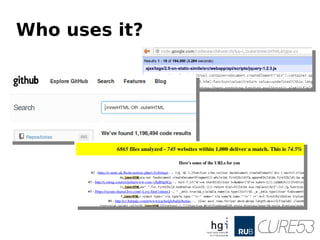
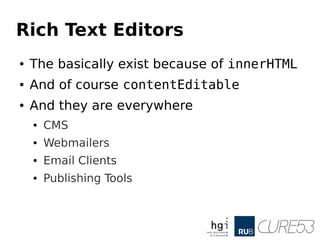
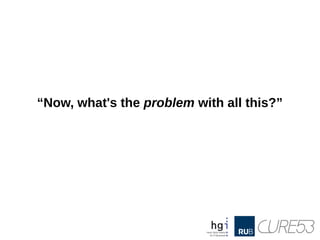

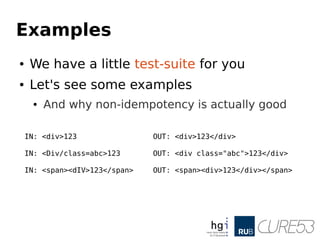
![Funny Stuff
● So browsers change the markup
● Sanitize, beautify, optimize
● There's nothing we can do about it
● And it often helps
● Some funny artifacts exist...
● Comments for instance
● Or try CDATA sections for a change...
IN: <!-> OUT: <!----->
IN: <!--> OUT: <!---->
IN: <![CDATA]> OUT: <!--[CDATA]-->](https://image.slidesharecdn.com/innerhtmlapocalypse-130425023611-phpapp02/85/The-innerHTML-Apocalypse-22-320.jpg)


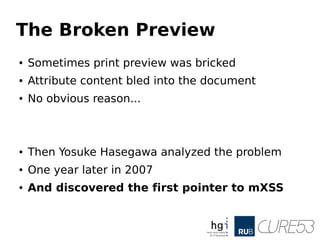
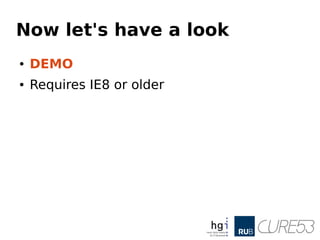

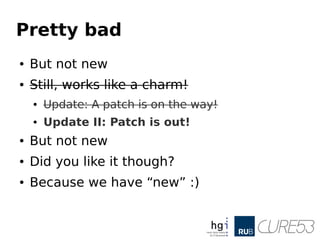
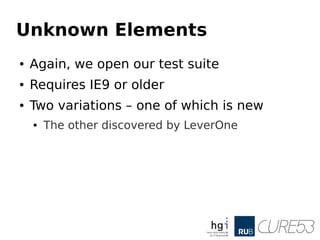
![IN: <article xmlns="><img src=x onerror=alert(1)"></article>
OUT: <?XML:NAMESPACE PREFIX = [default] ><img src=x
onerror=alert(1) NS = "><img src=x onerror=alert(1)"
/><article xmlns="><img src=x onerror=alert(1)"></article>](https://image.slidesharecdn.com/innerhtmlapocalypse-130425023611-phpapp02/85/The-innerHTML-Apocalypse-30-320.jpg)
